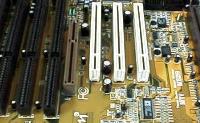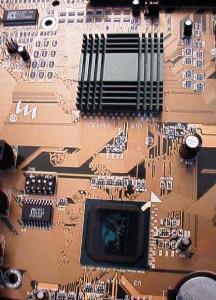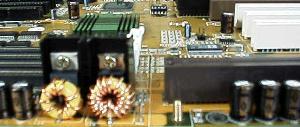MTech Stallion AT M628 LX Pentium II Board
by Anand Lal Shimpi on June 24, 1997 7:57 AM EST- Posted in
- Motherboards
| Socket Style: | Slot 1 |
| Chipset: | i82440LX |
| Cache: | N/A (On Chip) |
| Form Factor: | AT |
| BUS Speeds: | 60 / 66 MHz |
| Clock Multipliers: | 2.0x / 2.5x / 3.0x / 3.5x / 4.0x / 4.5x / 5.0x |
| Voltages Supported: | 1.5v - 3.5v (Auto Detect) |
| RAM Slots: | 4 168pin DIMM Slots (EDO/SDRAM) |
| AGP/PCI/ISA Slots: | 1 AGP Slot 3 PCI Slots 4 ISA Slots (1 Shared / 4 Full Length) |
| BIOS: | AMI BIOS |
| PCI EIDE Controller: | Super I/O 2 EIDE Channels 1 FDD Channel 2 Serial /1 EPP |
 |
If you decide to buy a Pentium II LX board based on the AT form factor specification you really don't want to sacrifice any expandability features or flexibility simply because you want to use an AT case. Not only are AT cases easier to find , but they are also cheaper and available in larger sizes than ATX cases. The Stallion AT features 3 PCI slots, 4 ISA and 1 AGP slot with the AGP slot oddly placed between the last ISA and the first PCI slot. The Stallion AT also features a roomy 4 DIMM slots making the 512MB cacheable area of the Pentium II easily approachable using 4 - 128MB DIMMs. |
| The layout of the Stallion AT is a force to be reckoned with especially since MTech managed to achieve such an excellent design when complying solely to the AT specification. In order to increase the flexibility of the Stallion AT, MTech opted to include both AT & ATX Power Supply connectors. As a result of this the Stallion AT's CPU fan connector is out of the reach of Intel's boxed Pentium II's fan power cable. Luckily MTech included an extension cable with the outstanding bundle the Stallion AT is packaged with to prevent any problems related to this from leaving your computer in a non-working position. Included with the Stallion AT is the standard set of IDE/FDD cables as well as a PS/2 adapter for PS/2 style keyboards or mice. MTech bundled the latest revision of Intel's Bus Mastering IDE drivers with the Stallion AT on one disk, and on its partner MTech provided the Windows 95 PCI Bridge patch to complete the package. |  |
 |
MTech's manual covers just about everything necessary to get the Stallion AT up and running, and although it is still a few steps away from the leaders when it comes to motherboard manuals (ABIT, Chaintech, etc...) it does cover the basics and then some. The manual provides a quick reference card in addition to the rest of the manual which simplifies some of the initial setup procedure with the Stallion AT. The M628 (Stallion AT) CPU setup function is controlled by a single set of dip switches that correspond to any of the available CPU clock speed settings. Unfortunately the M628 is limited to the use of only 2 bus speeds, the 60 and 66MHz frequency. The stability at all the achievable speeds however is outstanding, this can be attributed to MTech's intelligent use of 22 mid sized Electrolytic capacitors along side of 40 or so miniature capacitors and one oversized unit. To enhance this stability MTech designed the motherboard with a setup of 4 switching voltage regulators all covered with large heatsinks capable of dissipating great amounts of heat at any given time. |
Likewise, it is very apparent that MTech intended the Stallion AT to be much more of a motherboard than their previous Pentium II entry, the 440FX based R653. The M628 is much more stable of a motherboard and performance wise much faster of a motherboard than the R653.
| The Stallion's AMI BIOS is highly configurable, giving the user the options and flexibility necessary for this motherboard to be deemed a Tweaker's board. Unlike MTech's R653, the 628 covers most necessary BIOS memory timing options in the AMI setup, as well as report intelligent mainboard functions such as current CPU Temperature and CPU Fan Rotation speed. The user also has the option of selecting a CPU Temperature Warning Level to prevent any serious system damage in the event your CPU fan fails. |  |
Don't expect MTech's Stallion AT to be much of an overclocker, the maximum attainable speed using today's Pentium II processors with this motherboard is 300MHz, due to the lack of a 75 or 83.3MHz bus frequency. Another major problem the Stallion posed during the testing process was the unique manner in which the power supply configuration was setup. By default the AMI BIOS setup is assigned to enable the ATX power supply option instead of the AT power supply option, while the jumpers on the motherboard are set for an AT power supply instead of an ATX power supply. Therefore when setting up the Stallion be sure to double check the jumper setting onboard, MTech has informed me that this will be fixed in the next revision of the AMI BIOS to be packaged with the Stallion.










2 Comments
View All Comments
saratores - Wednesday, June 16, 2021 - link
My motherboard broke very often and it is very expensive to replace itthank you for this wonderful post. I took irishkm information for myself.
I also wanted to share with you a service that <a href="write" target="_blank" rel="nofollow">https://superessay.org/write-me-a-memo.html"&... my memo</a>.
Since I flew to rest at sea and I did not have time to do it physically.
The writer helped me, wrote in a few days. Their quality and speed are high
saratores - Wednesday, June 16, 2021 - link
I often changed the motherboard and it is very expensive to replace itthanks for this good article.
I received a lot of useful information.
I also wanted to share with you our service, which is <a href="write" target="_blank" rel="nofollow">https://superessay.org/write-me-a-memo.html"&... my memo</a> I flew to rest at sea, I did not have time to write it myself.
I was given an order a day later.
Their quality and speed are high